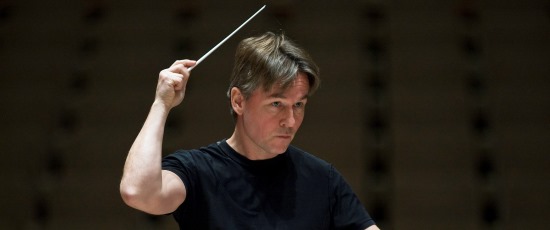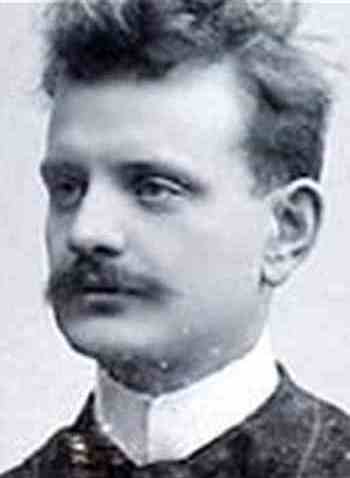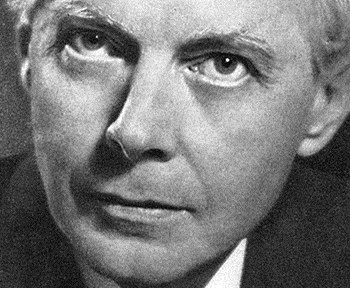With ‘Lemminkäinen’ epic, Salonen and CSO capture Sibelius in youthful flower, prowess
 Review: Chicago Symphony Orchestra; Esa-Pekka Salonen, conductor. At Orchestra Hall through April 8.
Review: Chicago Symphony Orchestra; Esa-Pekka Salonen, conductor. At Orchestra Hall through April 8.
By Lawrence B. Johnson
We tend to visualize Jean Sibelius as a stony visage that might have been excised from Mount Rushmore. It’s hard to remember Sibelius was once a young man – with hair! What’s more, in his hirsute young adulthood (and this we seldom consider) he already possessed prodigious gifts as a composer.
But what an excellent moment this is to reflect on Sibelius’ early mastery, in light of the great achievements by the twentysomething Schubert we’ve been hearing from the Chicago Symphony Orchestra and music director Riccardo Muti.
It is the fully flowered young Sibelius, before the First Symphony, caught up in the allure of Finnish myth and in absolute command of his symphonic craft, whom the CSO and conductor Esa-Pekka Salonen celebrate in a season-peak program heard April 3 and to be repeated April 8.
 Sibelius was in his late twenties when he began work on his “Four Legends from the Kalevala,” a 45-minute suite of symphonic poems that evoke the exploits of the mythic hero Lemminkäinen – a sort of Finnish Siegfried, with the difference that Lemminkäinen got the idea of women early on, and went for it often and everywhere.
Sibelius was in his late twenties when he began work on his “Four Legends from the Kalevala,” a 45-minute suite of symphonic poems that evoke the exploits of the mythic hero Lemminkäinen – a sort of Finnish Siegfried, with the difference that Lemminkäinen got the idea of women early on, and went for it often and everywhere.
This heroic Don Juan is one of several characters central to the “Kalevala,” an aggregation of Finnish myths that endured as a centuries-long oral tradition until Elias Lönnrot compiled the stories into printed form in 1835, then followed up with an enlarged tome in 1849. Sibelius read these national myths as a youth, and they provided the impetus for his most ambitious early works for orchestra.
The “Four Legends” – also known as the “Lemminkäinen Suite” – roughly outlines the hero’s mythic arc, and Salonen, one of today’s preeminent Sibelius interpreters, shaped each episode with almost verbal specificity. It must also be said that the CSO spun out these colorful yarns with an indulgence and inflection that suggested native familiarity.
To “Lemminkäinen and the Maidens of Saari,” a romantically lush depiction of the hero’s dalliance among island girls, Salonen brought a poetic blend of singing strings and blossoming woodwinds. In high contrast, “Lemminkäinen in Tuonela,” the place of death, sunny warmth gave way to icy harmonies reminiscent of Tchaikovsky’s evocation of Dante’s hell in “Francesca da Rimini.” Here the strings’ shuddering tremolos bespoke misery and bleak brasses betokened darkness without end.
 If the suite were an album, the third track would be its hit single: “The Swan of Tuonela.” You hear it in elevators. This, however, was something quite different, an intimate, arresting encounter with Sibelius’ sublime contemplation of the death swan, made both vivid and infinitely sad in the solo voice of English horn turned with consummate eloquence by Scott Hostetler.
If the suite were an album, the third track would be its hit single: “The Swan of Tuonela.” You hear it in elevators. This, however, was something quite different, an intimate, arresting encounter with Sibelius’ sublime contemplation of the death swan, made both vivid and infinitely sad in the solo voice of English horn turned with consummate eloquence by Scott Hostetler.
Luckless Lemminkäinen ended up getting killed and torn to pieces. But his devoted mother, a whiz with needle and thread, sewed him back together in time for the story’s happy ending, a chapter Sibelius called “Lemminkäinen’s Return” – a full-gallop allegro that Salonen and company brought off with bounding brio propelled by the signature driving rhythms that would animate Sibelius’ symphonies.
Romanticism with brilliant hues and a dark twist also marked the Salonen-CSO account of Bartók’s “Miraculous Mandarin” Suite. Written between 1917 and 1924, this lurid “pantomime” cause a mild scandal with its story line of a wealthy but mysterious mandarin lured to the embrace of a young girl only to be pounced upon by robbers, who attempt repeatedly but unsuccessfully to kill him.
 Wild, sensual and distinctly urban, Bartók’s “Mandarin” makes formidable demands on the orchestra, not least in its herky-jerky rhythms and careening shifts in instrumental groupings. In a sense, it falls somewhere between the primordial urgency of Stravinsky’s “Le Sacre du printemps” and the more contained, yet unmistakably Hungarian rhetoric of Bartók’s Concerto for Orchestra. Salonen drew a blistering, erotically charged performance from the CSO.
Wild, sensual and distinctly urban, Bartók’s “Mandarin” makes formidable demands on the orchestra, not least in its herky-jerky rhythms and careening shifts in instrumental groupings. In a sense, it falls somewhere between the primordial urgency of Stravinsky’s “Le Sacre du printemps” and the more contained, yet unmistakably Hungarian rhetoric of Bartók’s Concerto for Orchestra. Salonen drew a blistering, erotically charged performance from the CSO.
Still another exercise in rhythmic impulse opened the program: “<<rewind<<” by CSO resident composer Anna Clyne. The seven-minute work derives from what one might call the inverse narrative of a video tape zooming through rewind, its swooshing sound translated into rhythmic waves built up in the strings and accented by woodwinds and brasses. The CSO turned it into a heady delight – a fast ride, as it were, in a small machine.
Related Links:
- Performance location, dates and times: Details at CSO.org
- Preview of Chicago Symphony Orchestra’s complete 2013-14 season: Details at ChicagoOntheAisle.com
- A look ahead at Chicago Symphony’s 2014-15 season: Read about it at ChicagoOntheAisle.com
Tags: Anna Clyne, Béla Bartók, Chicago Symphony Orchestra, Esa-Pekka Salonen, Jean Sibelius

